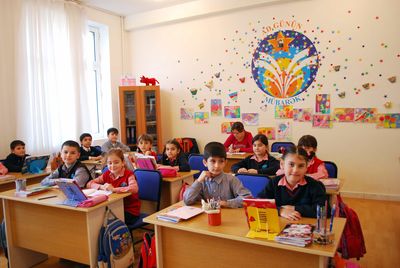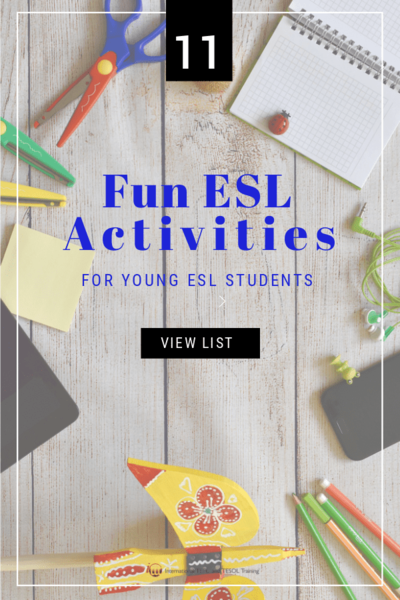11 Fun ESL Activities for Young Learners

When teaching young learners, it's important not to spend too much time on any one activity as they can soon lose interest. It is also a good idea to have activities that give younger learners the chance to move about and use the boundless energy they have at that age. Below we present a list of short activities suitable for young and very young learners of English.
Table of Contents
Are you ready to teach English abroad?
Check out what our course grads say in our many video testimonials!
Listen to this blog post:
What's the Time Mr. Wolf?
This is a good activity for practicing time with small classes. Clear a space in the center of the classroom and have a student stand in front of the board with their back to the class, this person is the wolf and the rest of the class stand at the back of the room. For each turn, the class asks the wolf 'What's the time, Mr. Wolf?' and the wolf replies with a time 'It's 3 o'clock'. The rest of the students then take 3 steps forward. The class keeps asking the question until the wolf says 'it's dinner time' at which point he turns around and tries to catch someone. The person he catches then becomes the wolf for the next round.
Also read: 7 Activities for Teaching the Present Perfect for the ESL Classroom
Telephone
Split the class into two teams. Have students stand or sit in a line and whisper a sentence to the first student. Each student then whispers what they heard to the next student until they get to the end of the line. The last student then says the sentence aloud. The team who is closest to the original sentence wins.

Basketball
Using an empty waste paper bin as the basket and a screwed up piece of paper as the ball, the students have to try and throw the ball into the basket. Before they can take their shot, they must answer a question from the teacher correctly. If they get the ball in the basket, they get 2 points. If they hit the basket but don't get the ball in, they get 1 point.
Also read: 7 Activities for Teaching the Past Progressive for the ESL Classroom
Volleyball
Use two chairs and a piece of string to make a net across the middle of the classroom and use a balloon as the ball. Divide the class into two teams and have them play volleyball. When a winning shot is played, the teacher asks the whole class a question, the team that answers correctly wins the point and gets to serve next.
Bingo
This classic game can be played with numbers, words or pictures on the students' bingo cards. The teacher calls out a number or word and the students mark off the corresponding number or word on their card. The first person to complete their card shouts out 'BINGO!' and wins the round.
Can you …?
The teacher asks students if they can do certain actions. If they can, the student answers 'Yes, I can' and then performs the action. If they can't, they say 'No, I can't' and the teacher asks them if they can do another action. Be sure to have some actions that are easy for shy students to do, e.g. 'Can you smile?'
Also read: 10+ Activities For Teaching English Summer Camp
I Spy
The teacher starts the activity by saying 'I spy with my little eye, something beginning with (...)' and chooses the first letter of the object. Students have to guess what object the teacher is thinking of. The first person to guess correctly takes over the teacher's position. For younger learners, colors can be used instead e.g. 'I spy with my little eye something that is red.'
Odd One Out
The teacher writes four words on the board, three of which are related to each other in some way, e.g. banana - apple - car - strawberry. The students have to say which word is the odd one out. This activity can be done with objects or pictures in place of words.

Stand Up Please
A version of Simon Says where the phrase 'Simon says' is replaced with 'please'. The teacher, or a student, asks the class to do certain actions but they must only do them if the teacher says please. Anyone who does the action without please being said is out of the game.
Mastermind
This is a good activity for older children. The teacher chooses a 4 or 5-letter word and draws the corresponding number of dashes on the board. The students have to choose a word of the correct length and one of them writes it on the board under the dashes. The teacher marks each letter with a tick, a circle or a cross. A tick means the letter is in the original word and is in the same place. A circle means the letter is in the original word but in the wrong place. A cross means the letter is not in the original word.
Also read: 7 Fun Activities for Teaching Vocabulary in the ESL Classroom
Blindfold Obstacle Course
Create a course in the classroom using chairs and desks, etc. (make sure that students won't hurt themselves if they bump into them). One student wears a blindfold and the rest of the class has to guide them through the course with directions, such as 'turn left', 'go straight on', 'climb up', 'stop', etc. Rearrange the course for each new blindfolded student.

Are you ready to teach English abroad?
These 11 activities are ideal for young learners in the ESL classroom and are also handy to know when you have some spare time in your lessons.
Apply now & get certified to teach english abroad!
Speak with an ITTT advisor today to put together your personal plan for teaching English abroad.
Send us an email or call us toll-free at 1-800-490-0531 to speak with an ITTT advisor today.
Related Articles:
- Why You Should Take Specialized TEFL Courses
- The 5 Best Ways to Build Rapport With Your TEFL Students
- The Best Apps to Have on Your Phone While Teaching English Abroad
- 7 Steps to Paying Off Your Student Loans While Teaching English Abroad
- 5 Reasons Why Teaching English Abroad Enhances Your Career Prospects
- Two Traveling Teachers Share What It's Like Teaching English Abroad as a Couple




